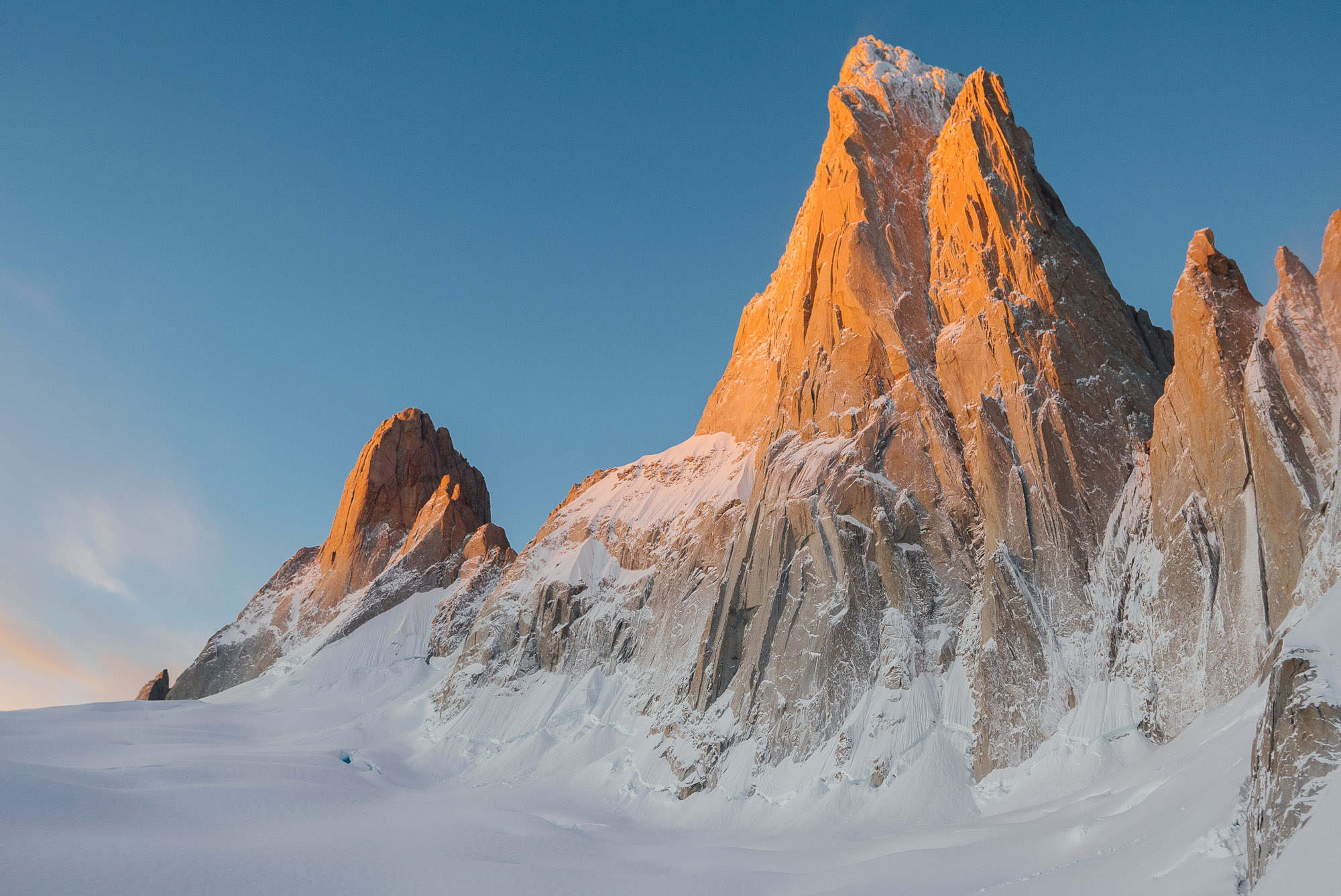
Fitz Roy and Poincenot, early morning.
Patagonia
I wasn’t sure what to expect going into my trip to Patagonia. I had just emerged from a period of low motivation and I wasn’t sure I was quite through with it yet. Would I feel like I was wasting my time and taking unnecessary risk? Was I going there just because it was the thing to do? Patagonia was a place I had dreamed of going to, but maybe I’d feel out of place…like I shouldn’t be there.
I think I went at a good time though. With the skills and experience I’d acquired over the last couple years, Patagonia ended up feeling like something I could truly enjoy. I wasn’t overwhelmed by it. I was ready for it. I made safe decisions and I had fun. And it honestly was some of the most inspiring climbing I’d ever done.
Five weeks were set aside for the trip. Pretty much the month of February. A good amount of time. Three weeks seems like the absolute minimum to give yourself a fair shot of climbing something, as the weather could be bad for weeks on end. With five weeks, I should for sure be able to climb something… Even then I wondered if I’d have enough time.
I came into the trip with zero expectations. I knew that if the weather was bad in the mountains, you could still boulder in Chaltén, the town climbers stay in. That was the only expectation I did have. I joked that it would be my longest bouldering trip. I’d never been on one longer than a few days, but maybe the weather would be so bad that I’d just boulder for five weeks. I was prepared to be OK with that. That mindset proved to be a good one because the first two weeks I was there, I only bouldered. And it’s not a bad backup plan—the bouldering is really good. We met several climbers who traveled to Chaltén just for the bouldering. The pad situation, however, is not good, and I ended up mostly climbing on boulders that the locals had padded or climbing traversing problems low to the ground that needed little to no padding. The traverses got a little old by the end of the trip. It’s nice to climb up.
The daily routine in Chaltén starts out with coffee brought from the States—because you can’t find good coffee down there—and reading weather forecasts. “When’s the next window?” was the question constantly in our minds. Often what seemed like a clearing a week out would completely disappear in a few days, and most “windows” would deteriorate in length and quality by the time they finally arrived. A couple times it looked like we were going to get a four or five day “mega window,” and both ended up being merely one, or maybe two separate days of good weather.
There is a lot of pre-window talk down there. Everyone wants to know what everyone else is planning on climbing. But the talk was usually a waste of time because the weather changed so much. Before most windows, we didn’t have a solid-ish plan till the day before. One time we didn’t decide which side of the range we’d hike into until 30 minutes before leaving.
Finally a three day window arrived—really just two good days with a bad day in the middle. The first day of that window was going to be too cold to rock climb, so Austin Siadak—my main climbing partner for the trip—and I decided that we should go for a “winter” route—basically a route we could climb in boots, crampons, gloves, and ice axes, verses “rock climbing” with bare hands and rock shoes. We decided to try the Whillans-Cochrane on Poincenot.
Poincenot, the third highest peak of the Torre and Fitz Roy spires, is one of the most beautiful in the Fitz Roy group. Its prominent and piercing spire competes with Fitz Roy (Cerro Chaltén, as it’s locally known) itself. Due to recent warm weather and storms, the snow ramp leading to the start of the “technical” climbing was melted out and then covered with fresh storm snow. We arrived at the base of the route as several parties were bailing. The loose snow over rock didn’t look ideal. I was psyched to have Austin’s Patagonia experience for what turned out to be an earlier-than-expected crux at the beginning of the route. If it weren’t for him, I would have joined the fleeing parties.
Once we made it to the mixed “crux” (M4 or 5 in the current conditions), I took the lead, only because I felt bad about all the leading Austin had been doing up to that point. After navigated a scary slab in crampons, we were cruising on solid rock and good ice—comfortable territory for both of us. As we rounded the mountain and made it to the summit, I got my first views of the Torres—some of the most beautiful spires of rock in the world. Even though I never got to touch rock with my bare hands and rock shoes, Poincenot was an amazing and very memorable first Patagonian climb for me. It was also important for Austin—it was the last spire in the Fitz Roy skyline that he had not climbed.
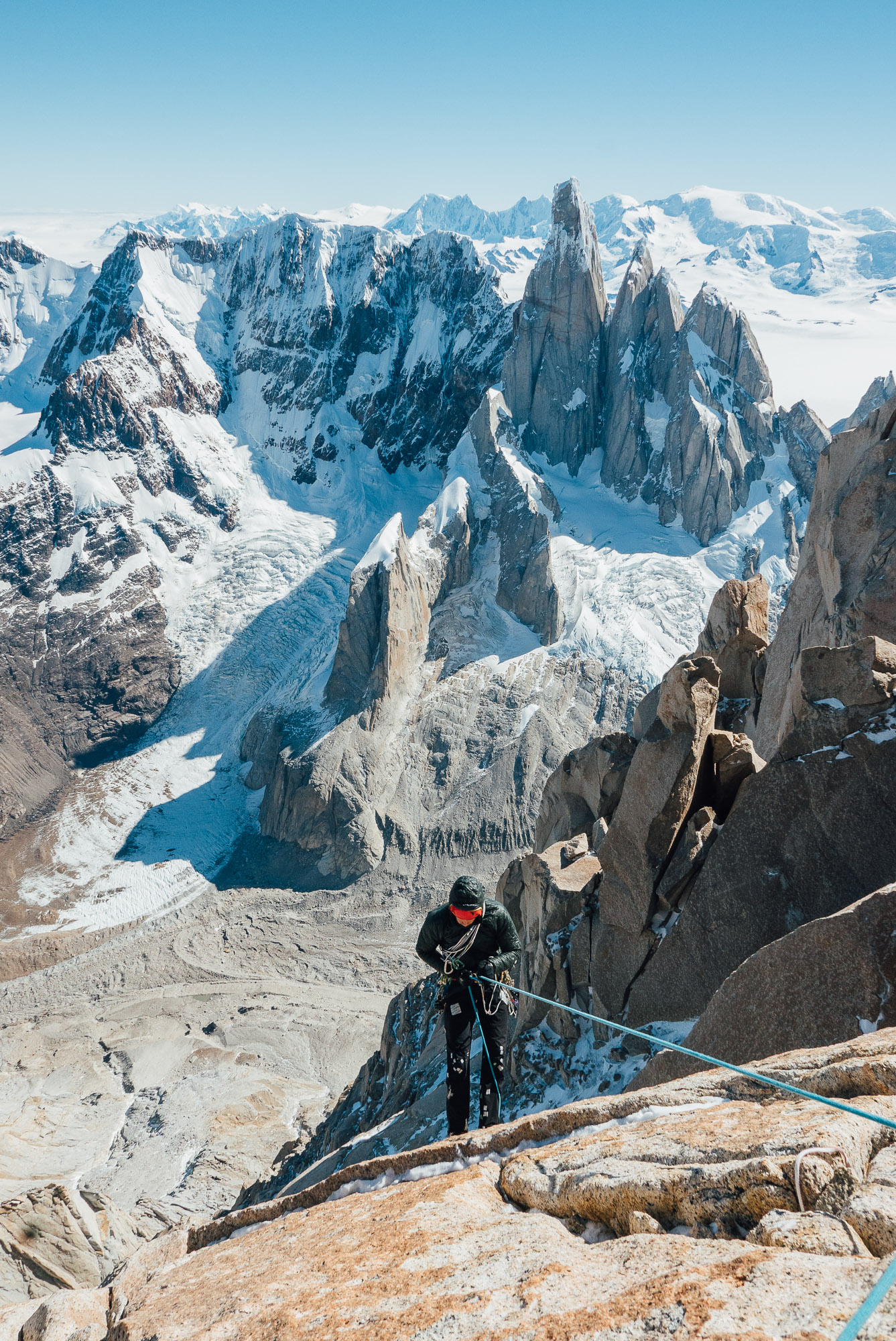
Austin rapping off the summit of Poincenot with the Torres in the background.
After Poincenot, Austin and I rested out a rainy and windy day in high camp and prepared to attempt Aguja Pollone with Colin Haley and Andy Wyatt the next day. We planned to climb a route called La Granja via the Japanese direct start as two teams of two. The pitches on this route ended up being some of the best alpine rock pitches we’ve ever climbed. Splitter hand and finger cracks, and hero jug flakes. The whole route follows a prominent eastern arête that juts out over an epic glacial landscape. The quality of the climbing, the beauty of the line, the mountain, and position make this route destined to be a classic. The whole day was type-1 fun—a rarity in such serious mountains.
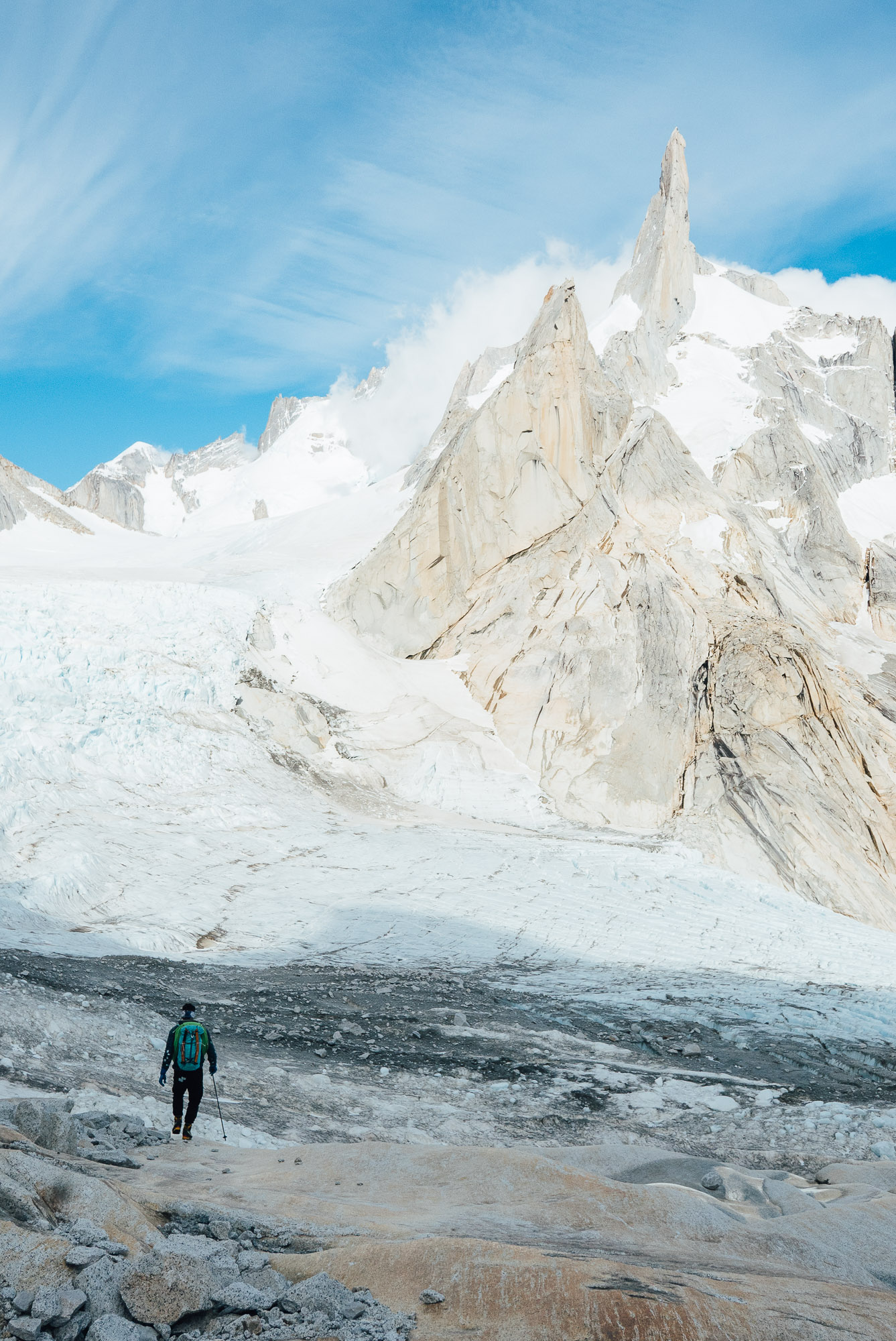
Colin approaching Aguja Pollone.
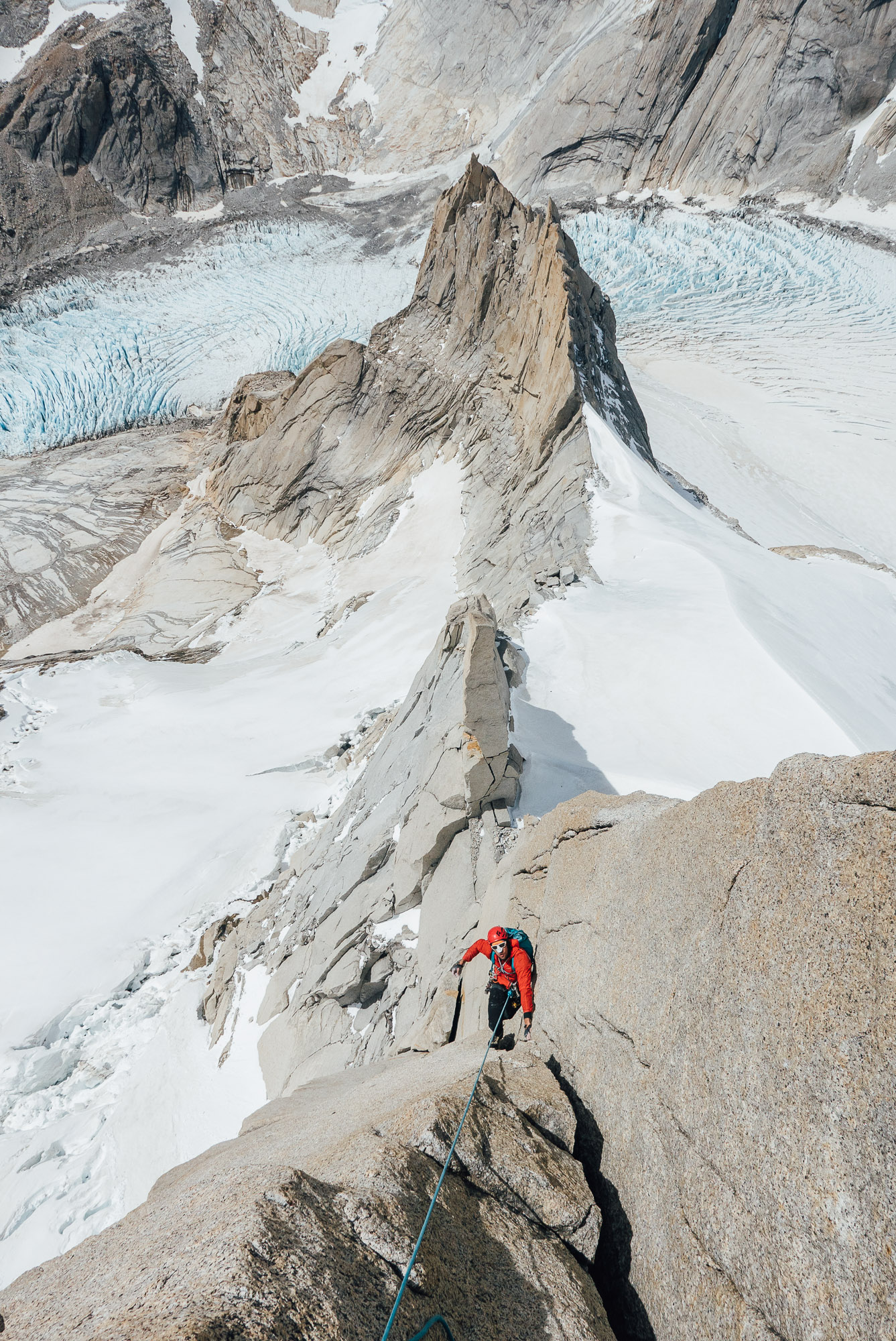
Austin on one of the many amazing pitches of La Granja.
Back in town, we did more bouldering and trail running and religiously checked the forecasts for the next window. The scene in town is beautifully social—lots of climbers hanging around and waiting for good weather. El Chaltén is small, but because of its booming recreational appeal as the “trekking capital of South America,” it has many small grocers, cafes, restaurants, and even a brewery. Most days in Chaltén ended with happy hour at “Fresco,” where climbers gather and share stories of the last window, celebrate successes, and bond over surviving another day in Patagonia.
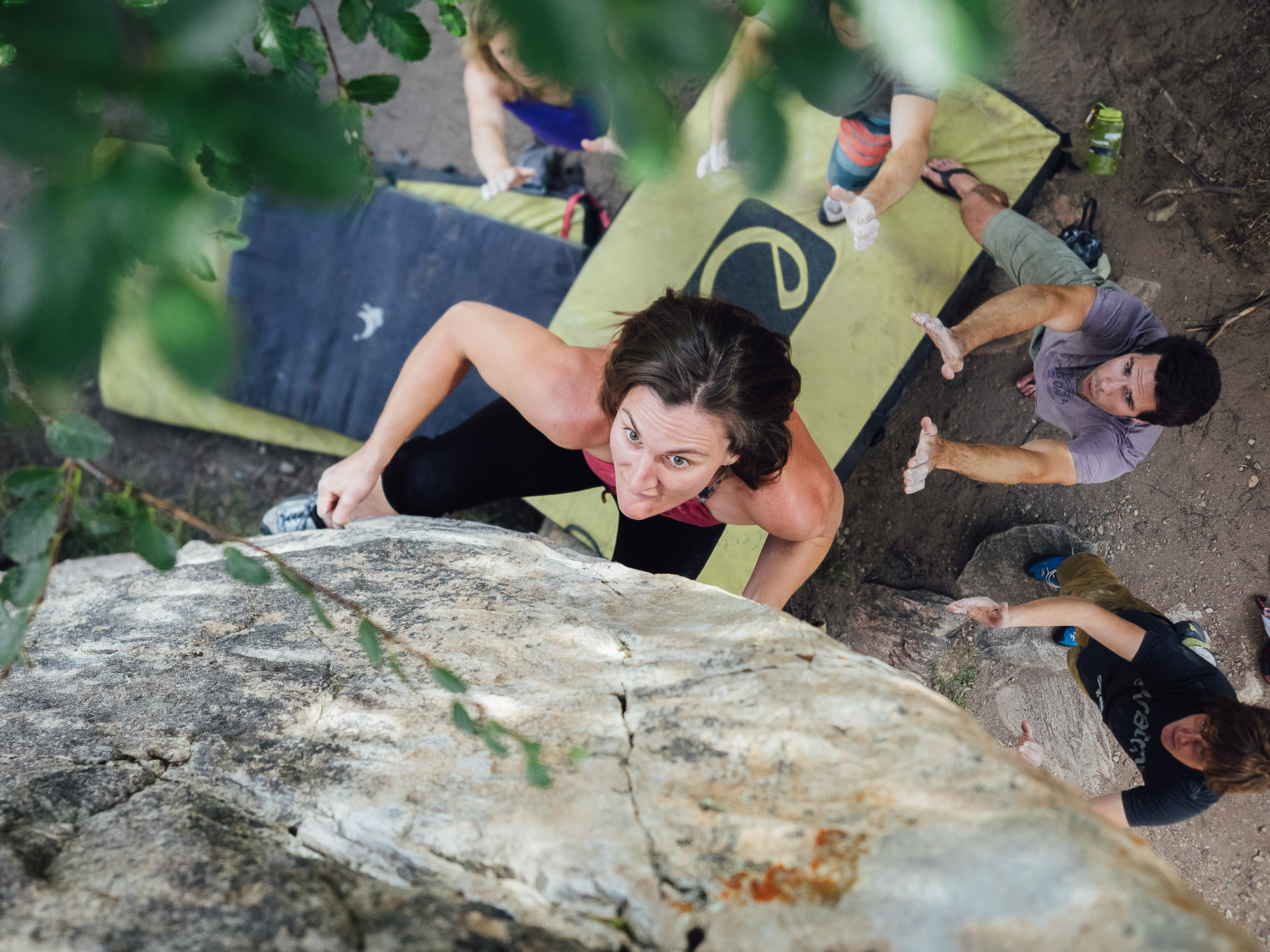
Josie trying to decide if she wants to go for it.
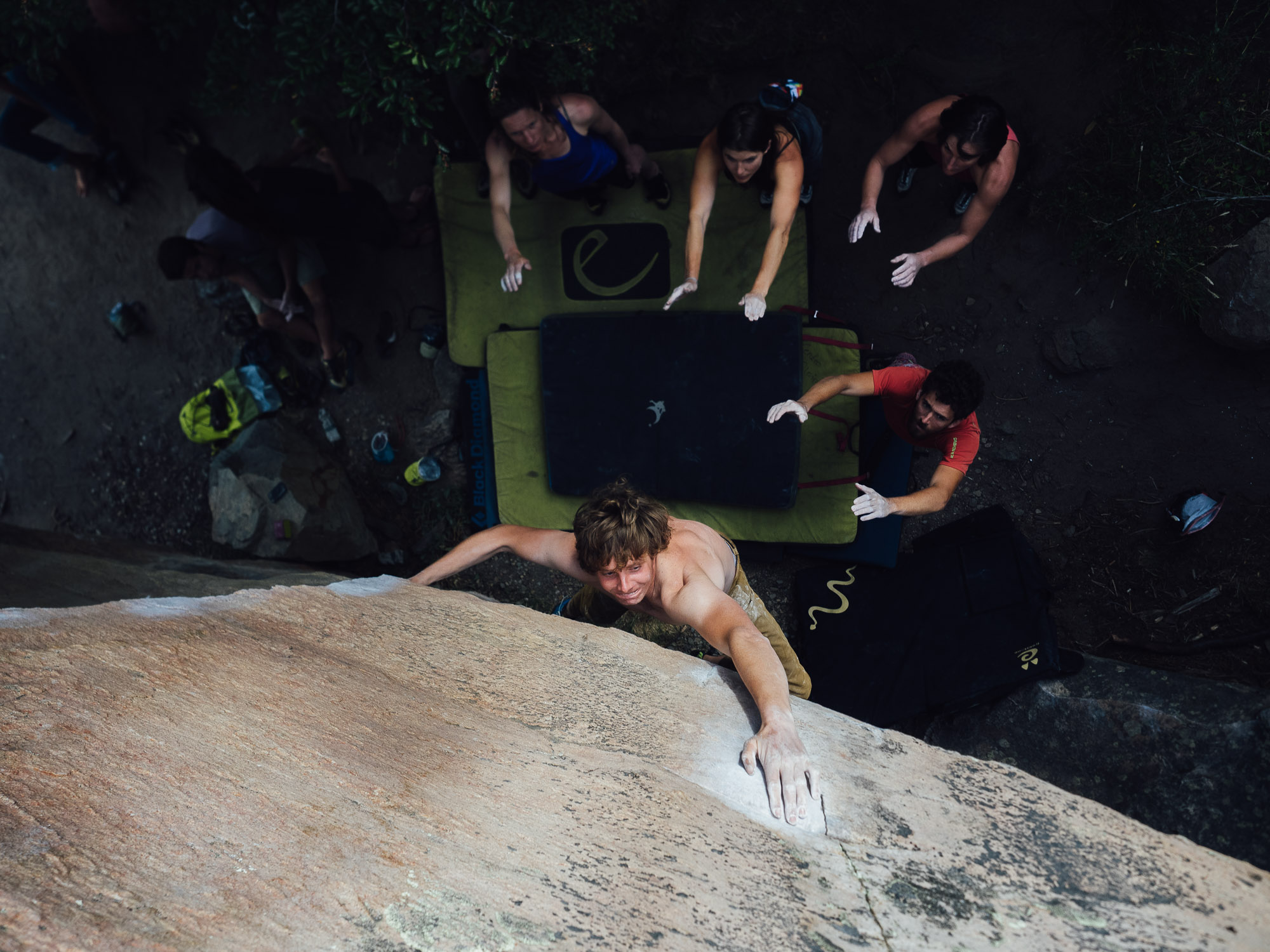
Will on 'Gato Negro.'
Later that week we got a small blip of good weather—not enough time to spend a night in high camp—so we would have to get in and out of the mountains Chaltén-toChaltén. Andy and I decided to team up to do a quick climb of Guillaumet, a mountain neither of us had climbed and one of the most accessible for a town-totown mission. Andy is the owner of the climbing gym I routeset for and super talented athlete. Him and Colin Haley set the car-to-car speed record of Fitz Roy and, back in Washington, Mt. Stuart's North Ridge. I was excited to see if I could keep up!
We climbed a “sit-start” to the most popular route, the “Fonrouge”—in total, a 2500-foot ridge climb. The day, although windy at times, was beautiful, and the route was easy enough to climb mostly unroped, save a few pitches. The route could be considered the “North Ridge of Stuart” of Patagonia…although not quite as good. We traveled about 18 miles that day, climbed a 2500-foot route, gained 6500 feet, all over about 11 hours—still a lot of ground to cover for being one of the most accessible routes! (A couple weeks later, a group of climbers did that same thing two hours faster!)
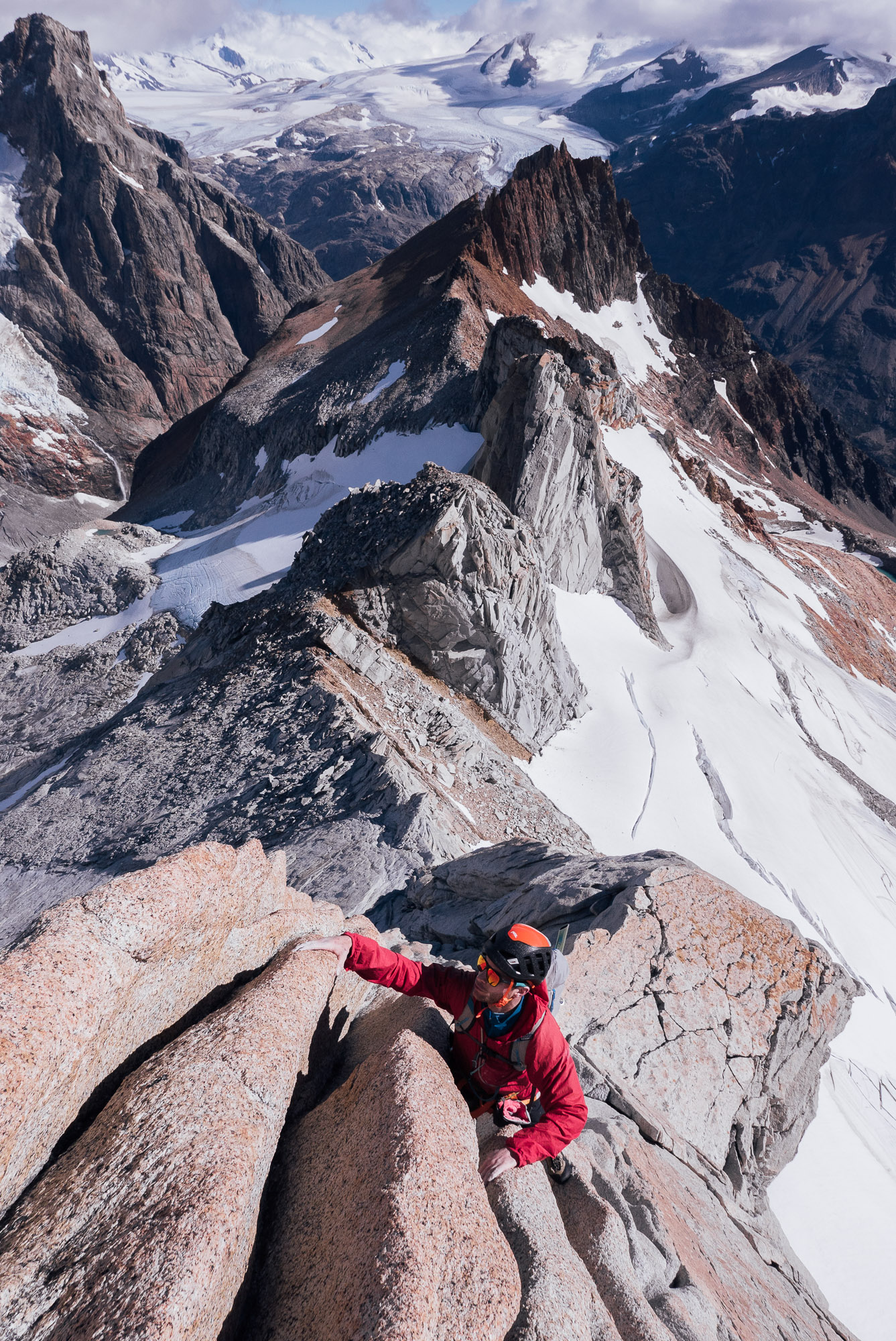
Andy low on the ridge.
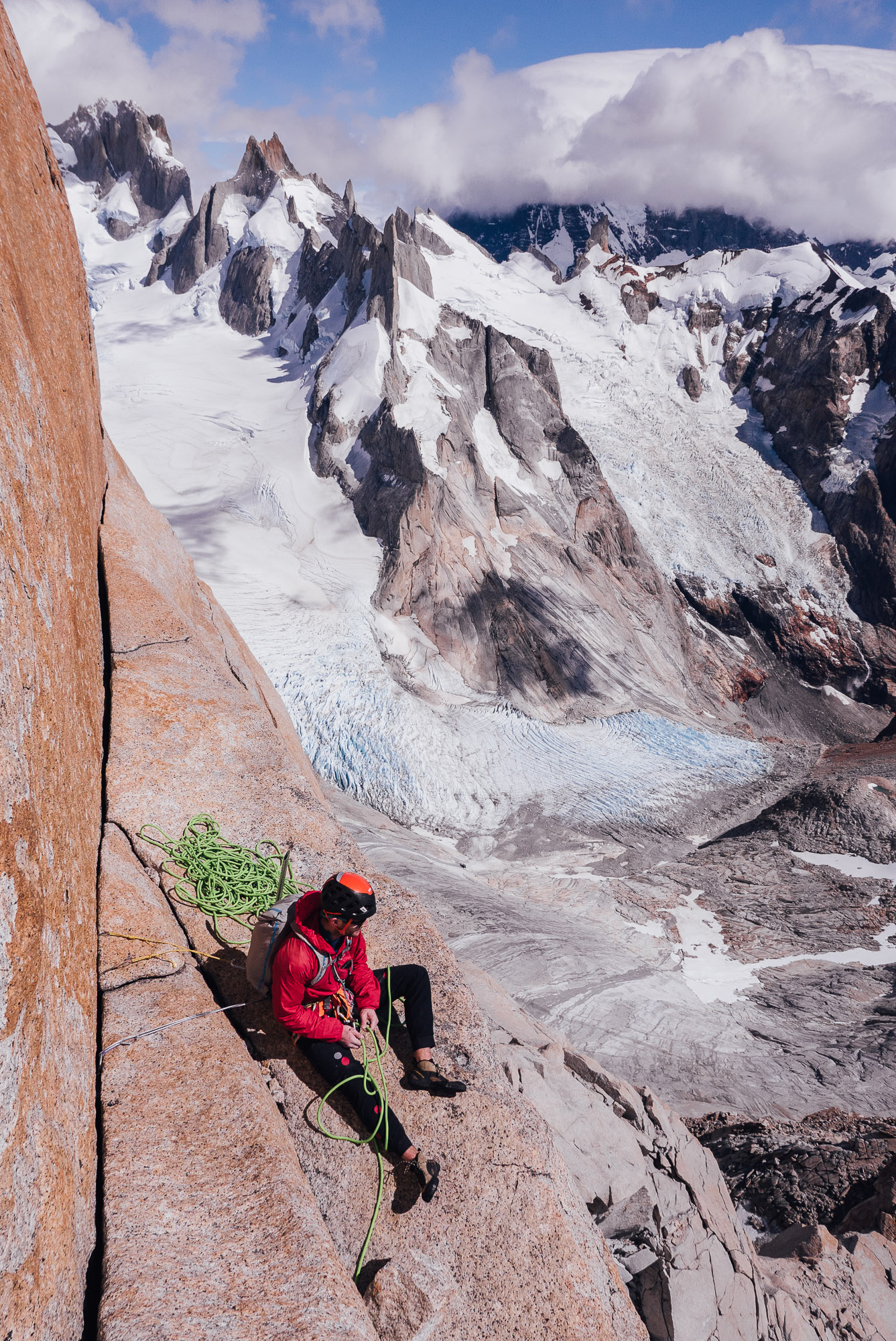
Andy at a belay after the crux pitch of the Fonrouge.
Three weeks had flown by and I was beginning to feel like I was running out of time. Eventually some promising weather showed up on the horizon. But first more bouldering, trail-running, and happy hour-ing.
I would of loved to do something new in the mountains down there—a first ascent or a first free ascent. For me climbing is more rewarding the more it is creatively expressive. But ultimately we never got the weather, and for the little windows we had my priority was to just explore and get to know the range and climb some of the classics. I did, however, come out of the trip with a Patagonian bouldering first ascent—one of my most memorable experiences down there. At the annual Festival de Boulder in Chaltén, I climbed on several freshly cleaned boulders that some locals prepared just for the festival, and I managed to be the first to climb one of them, quite possibly the “king line.”
The line goes straight up a tall and clean 40° overhang with cool holds and great movement—about all you could ask for. When I walked up to people trying the line, most of the climbers were taking epic falls from the top, missing the pads, and thankfully being caught by a large group of spotters. I assumed someone had already climbed it and I gave it a few tries, dropping off each time because I was scared. Then I heard that it actually hadn’t been climbed yet, so I decided to give it a little more effort. After a couple more tries, I found a body position in which I felt in control, committed to the last few moves, and pulled over the lip. I felt like I was competing again, and it brought back a exhilarating memory of a cheering crowd when I was the only person to send a route at nationals. I called the line La Puerta Abierta, “The Open Door,” upon recommendation from Austin who heard someone yell, “the door is open!” after I topped it out. The name also recognizes those who worked hard to prepare and save this boulder for the festival. It’s about V9, with maybe a half-grade granted to it due to its committing nature.
Finally, in my last week, some good weather came and Andy, Austin and I decided to try a route out of the Torre Valley. We attempted “Last Gringos Standing” on St. Exupery, but only got a couple pitches up before bailing because of wind and cold. I think that day turned out to be much colder than expected and a number of parties had to bail. Perhaps we could have chosen an easier and more sheltered route, but I’m not sure we could have known how bad it would be. Our one failure still ended up being a great camping trip—the Torre Valley is likely the most beautiful place I’ve ever been in my life.
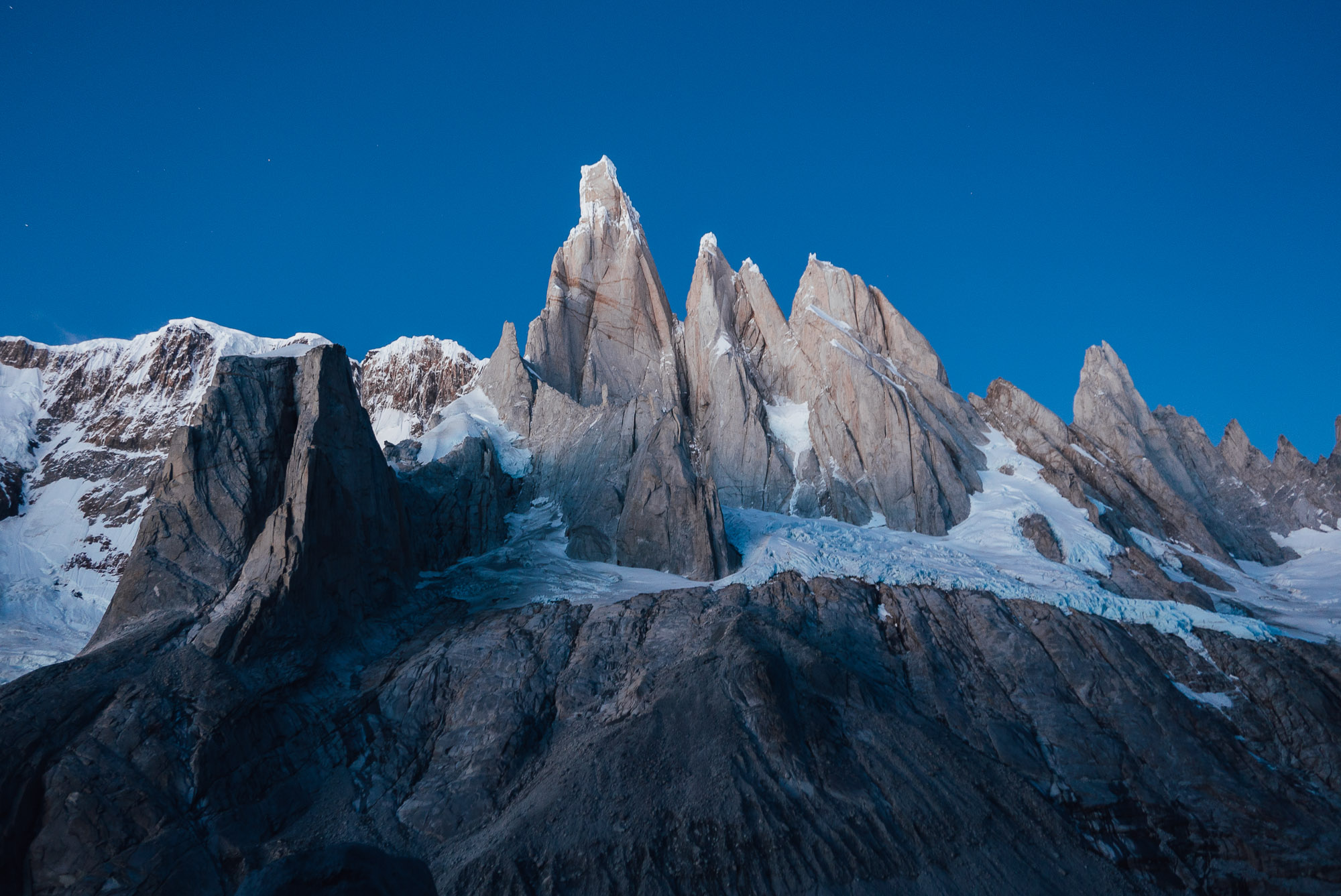
The Torres at dawn from the Torre Valley.
After hiking out of the Torre Valley in a storm, I only had a few days left before my flight back home. The forecast showed one last day of good weather the day before I had to catch a 6am bus to the airport. If we went for something big, I would likely have to hike solo across a broken glacier and navigate a descent I’d never done before in the dark. It would be a bit risky and a bit of a gamble with the possibility of missing a very expensive flight. But there was one route, the Pilar Rojo on Mermoz, that I really wanted to climb, so Austin and I decided to go for it. At high camp, a couple good friends from Seattle, Andy and Kelsey, offered to help me get out of the mountains safely and in time for my bus. They had a car and would wait for me to get back to the road via a trail I knew well, and drive me back to town, so I wouldn’t have to navigate an unfamiliar technical descent on my own. I didn’t have access to a car and it would’ve been too late to get a taxi, so I hadn’t considered this option, but it was a huge relief when they made it possible.
The next day Austin and I successfully climbed the Pilar Rojo with four of our other friends right behind us. We almost onsighted the consistently 5.11+, 2000foot climb, except for a short slab traverse that Austin aided through and I sent third try. It was a battle to keep it together for the last bit of burly crack climbing—Austin was cramping up and I just felt super tired. The climbing was the definition of “splitter,” almost too splitter for me, a pretty mediocre crack climber. We got off the mountain in the light and I ended up making it back to town by 3am. After a two-hour nap, I caught my bus to the airport, and was quickly transported back to Seattle. I felt extremely lucky to end my trip with such a high quality Patagonia free climb. It’s possible that that last day was the only day that conditions aligned enough to make climbing the Pilar Rojo possible. A couple of our friends had attempted that route several times that season and never got a chance to take it to the top.

Austin on the first 11d pitch. Splitter!
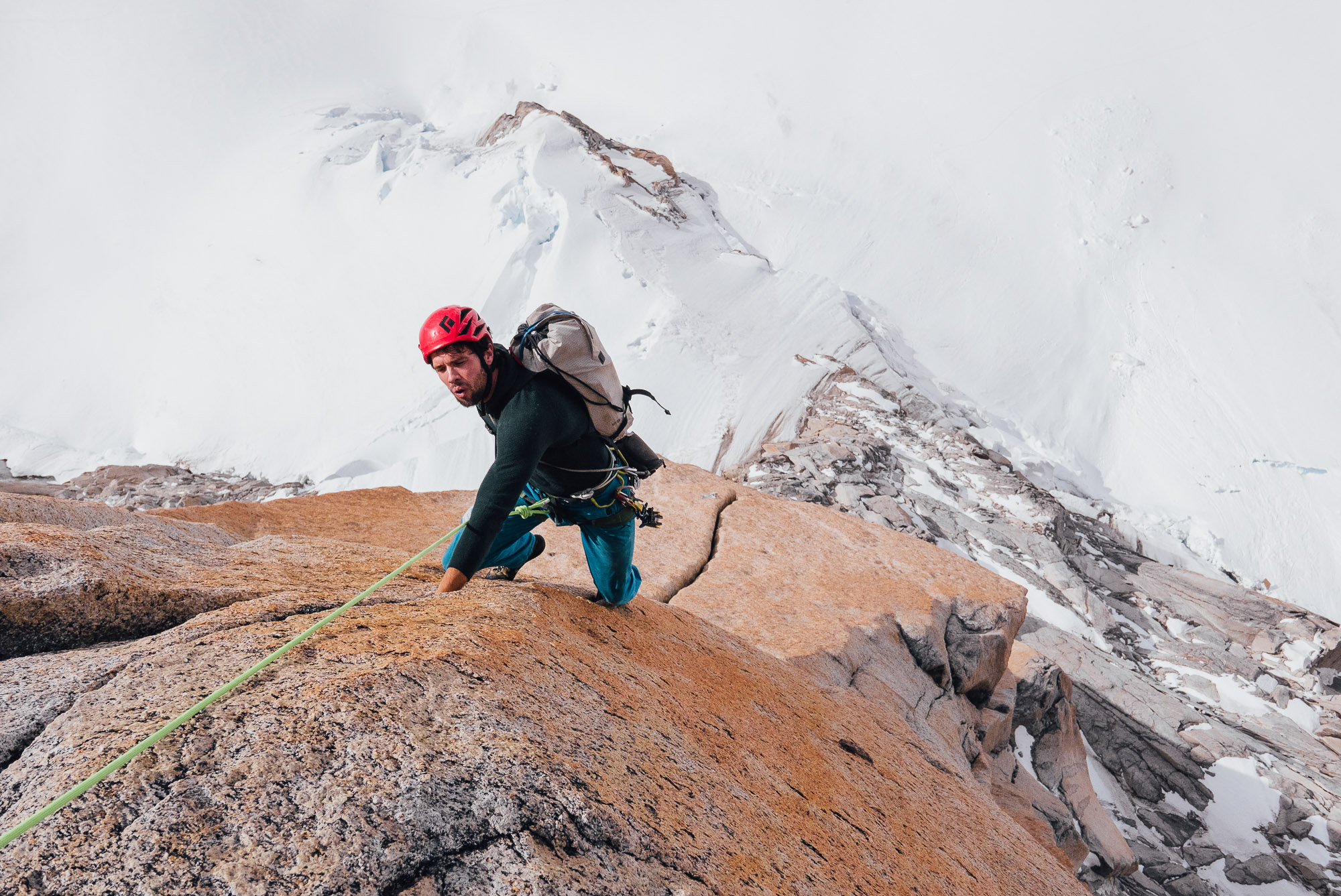
Austin on one of the only 5.10 pitches. Splitter hands for 200 feet!
Naturally, I wonder if I’ll go back to such an amazing place. When I was down there I was already talking about being back next year. Back home, I wonder if I’d like to use my “big trip budget” to see another part of the world. I’m sure I will eventually go back, but I’m not sure when. I honestly was surprised at how high-quality the alpine granite was—it really is good. But what wasn’t surprising was how hard it is to get good conditions to rock climb—Patagonia’s stormy reputation is extremely accurate. That’s partly what makes it special though, and also what would make a rock climber like me secondguess going back! Doing a rad alpine rock climb down there is not guaranteed, but I was lucky to do a few.
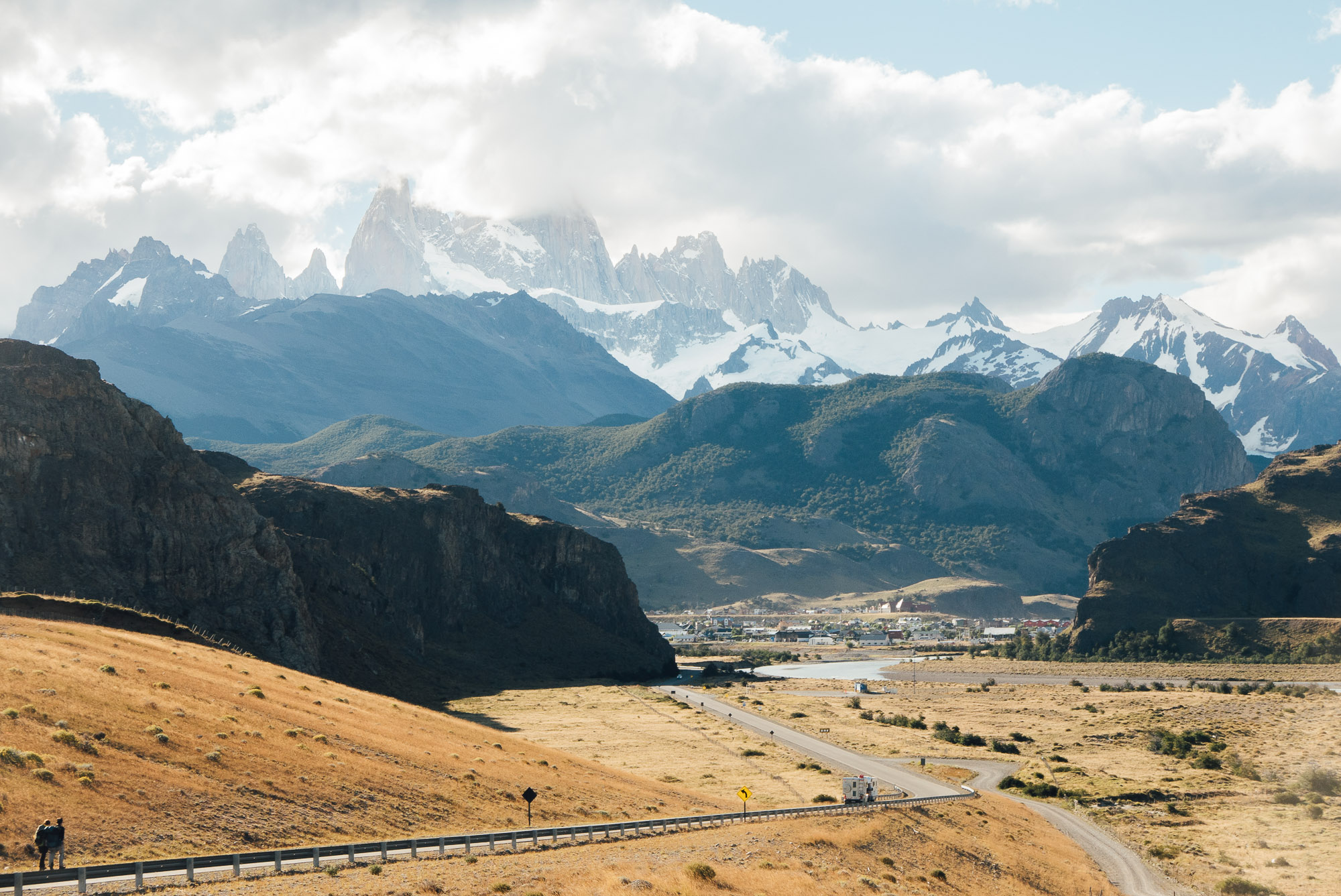
Chaltén below a shrouded Fitz Roy.
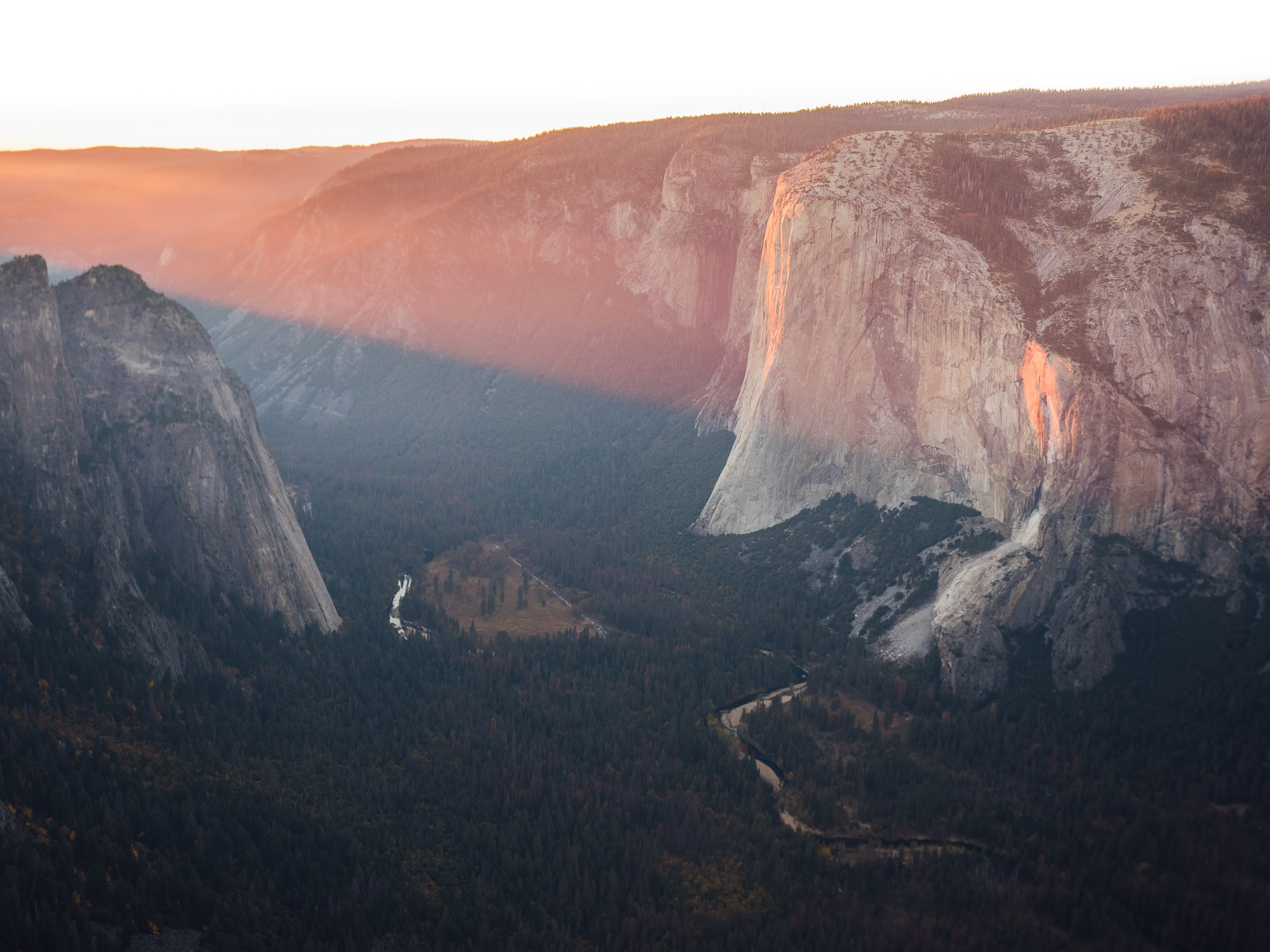
Middle Cathedral (left) and El Capitan.
Dark Side of the Valley
When you drive into Yosemite Valley, El Capitan is one of the first things that you see—one of the most beautiful hunks of stone on the planet, and the object of many climbers’ dreams. And this definitely goes for me. I too am irresistibly drawn to climbing’s Great Supermodel.
And so it was my plan to get intimate with the Supermodel this last October. I hadn’t been to the Valley in 10 years—the last time I was there, I was 15. Now, in my great climbing maturity, I was ready for the Captain. And I believed I was ready to free climb it. But unfortunately for me, due to heat and crowds, the trip ended up being a tour of some hard and classic free climbs on the shady side of the Valley.
Blake Herrington and I arrived in El Portal late on a Friday night, October 20th. The plan was to sleep in a bit and get a casual start for a route on Fifi Buttress. Blake wanted to get on Romulan Warbird (V 5.12c), but I wanted to go straight for Final Frontier (V 5.13b). Blake put forth that we should start slow and I had to relent. I was probably being too ambitious.
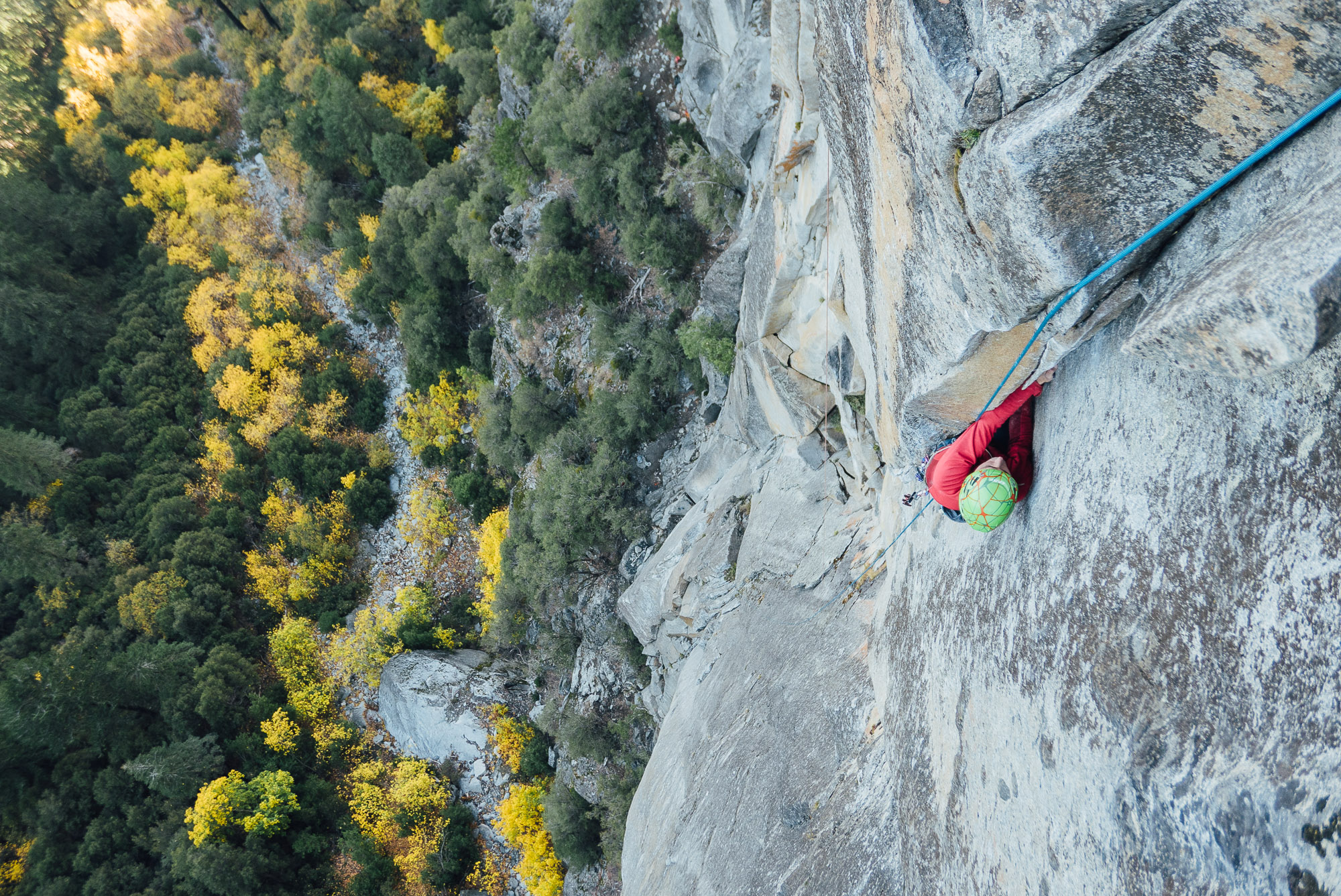
Blake on Romulan Warbird.
The next morning, we were at the base of the route at a causal 11pm, with our friends Nik Berry and Bronson Hovie 2 pitches above us. “How was the first pitch?” I yelled up at Nik. “Kinda hard. And the rock doesn’t feel very grabby.” Blake and I tossed a carabiner for the first lead. The CAMP side landed up and the 12b warmup pitch was all mine. I eked through it, and so did Blake, and we continued to eke our way through the rest of the route, including two more pitches of 5.12. The climbing was amazing, and the belay ledges were even more amazing—key ingredients for a classic free climb. I would climb this route many more times, and was glad Blake pushed for it. It was a great way to start our trip.
Coming from Washington, and especially coming from climbing at Index, it was a relief to be able to climb 5.12 pitches on granite first try fairly comfortably. (5.12 is also no gimmy at “local” PNW crags like Little Si, Squamish and Smith!) Not very many climbers have onsighted Index 5.12, and by the end of our first day, I had already onsighted more 5.12s in Yosemite than I had ever at Index.
Two days later, we were back at Fifi Buttress for Final Frontier. We were psyched to have some 5.11 pitches to warm-up on this time. When arrived at the crux block of 12d, 13a, 13b, and 12c, we were psychologically taken out by poor stances and poorly situated belays. The anchor bolts were always just left or right of the stance, so that you were forced into a hanging belay with ledge just out of reach! I onsighted the first 12d, sent the 13a, and felt close on the 13b after one try, but Blake wasn’t as close to sending and we were both a little irritable from having to hang in our harnesses so much, so we called it and rapped from the base of the 12c. Several days later, I returned with my friend Austin Siadak to finish the route and lead every pitch with no falls. Almost all of the pitches on this route are amazing. Nik Berry and James Lucas did a nice thing by freeing this route, though I have a slight grudge against them for not making the belays more free-climbing friendly. Alas, it is all of our responsibly though, and I could have done it myself.
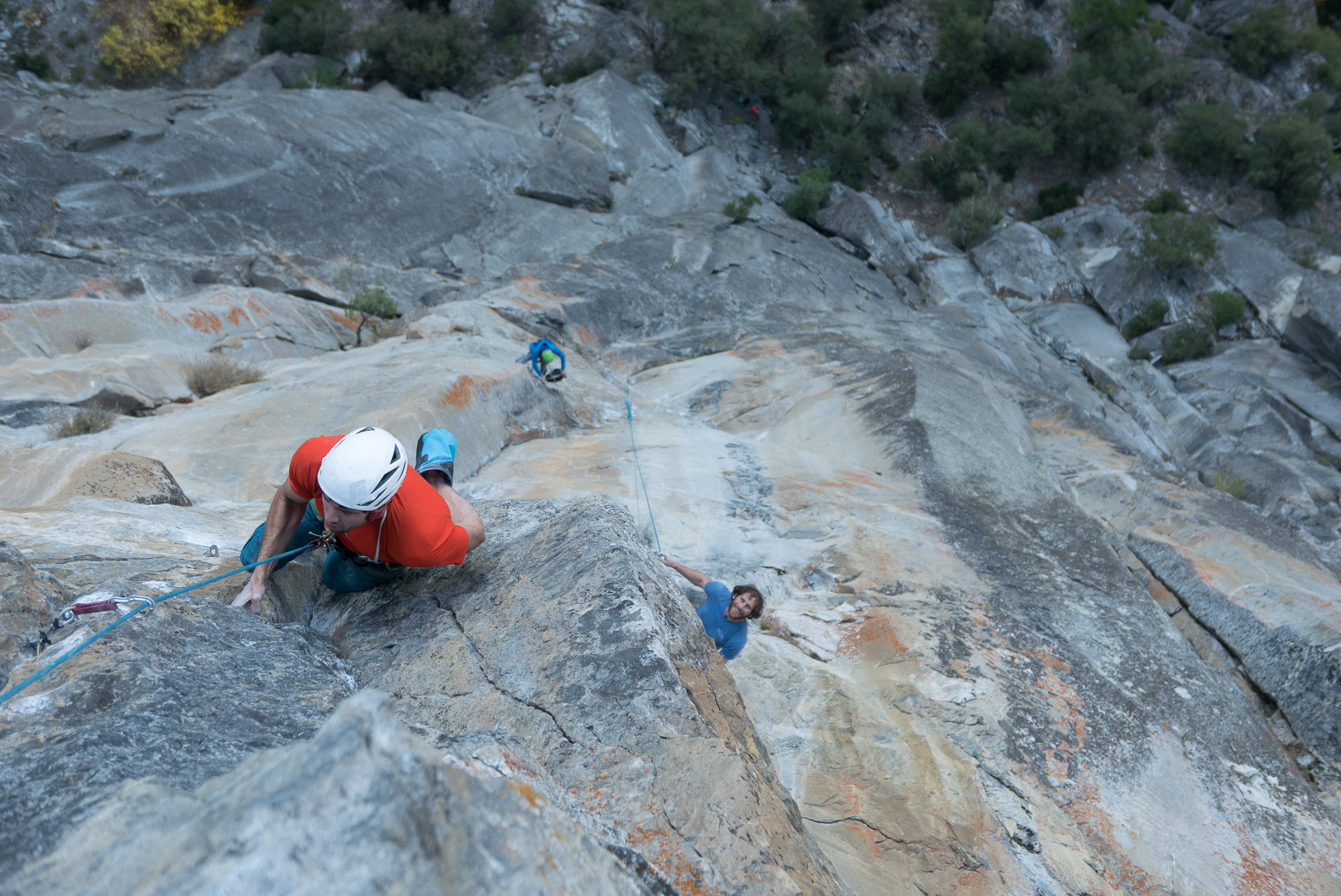
Austin on Final Frontier, with Max and Blake below.
We wanted to climb the next day but didn’t want to hang in our harnesses at all so we decided on the Rostrum (IV 5.11c), which supposedly had good ledges, not-to-mention it being a Yosemite classic. The night before climbing it, Austin, Blake and I sat in the living room of our place in El Portal discussing how to climb it most efficiently as a team of 3, and decided to try climbing the route in 5 long pitches, leader fixing, and the two followers following simultaneously on mini-traxions. We called the middle follower the parasite. This ended up working well. On a somewhat non-meandering route, the two followers were not pulled to the side at all. Blake and Austin said that even following the traverse on the last pitch was smooth. After leading a 200ft pitch, the leader could just chill, and work on a crossword puzzle, or some other productive thing. No trying to belay two people simultaneously, and since we only needed one rope, and because it was always just hanging straight down below us, there was literally no rope management work necessary. Just long glorious pitches. We were slowed down a bit by a team from Norway, but we’re good friends with them now, and found out that the granite in Norway is better than Squamish and Yosemite. But what about Index? TBD. I think we started at 1pm and finished around 5pm.
After the Rostrum, our friend Max Tepfer arrived in the Valley. It was still quite hot, and wanting to try a route on a different formation, we decided on Border Country (V 5.12c) on Middle Cathedral. Blake used a random number generator on his computer to decide who would climb with who. On this party ascent, I’d climb with Max, and Austin would climb with Blake. Max and I simuled the first 7 pitches to the crux headwall in 3 leads. The intro pitches were fun featured 5.8-5.10 face climbing, but the real gems of this route are the 4 headwall pitches of 12a, 12c, 11+ and 11+. Max wanted to lead the 12c, which he had tried before, but hadn’t sent, so we decide to swing leads with me starting with the 12a. I onsighted this pitch and after watching Max’s beta for the low crux on the 12c, flashed that as well. The 11+ pitches went smoothly for both of us and we stopped back at the crux 12c on our way down so Max could re-lead and send. Blake and Austin were above us at this point and Austin took one of the better iPhone photos I’ve seen of Max hiking the thing in the day’s last glimmers of light. Send of the day. The features, the knobs, odd pockets, and ribs were amazing. Those four pitches contained some of best, most interesting granite I’ve ever climbed on. Thanks Jeremy Collins, Dana Drummond, and Mikey Schaefer for the beautiful route!
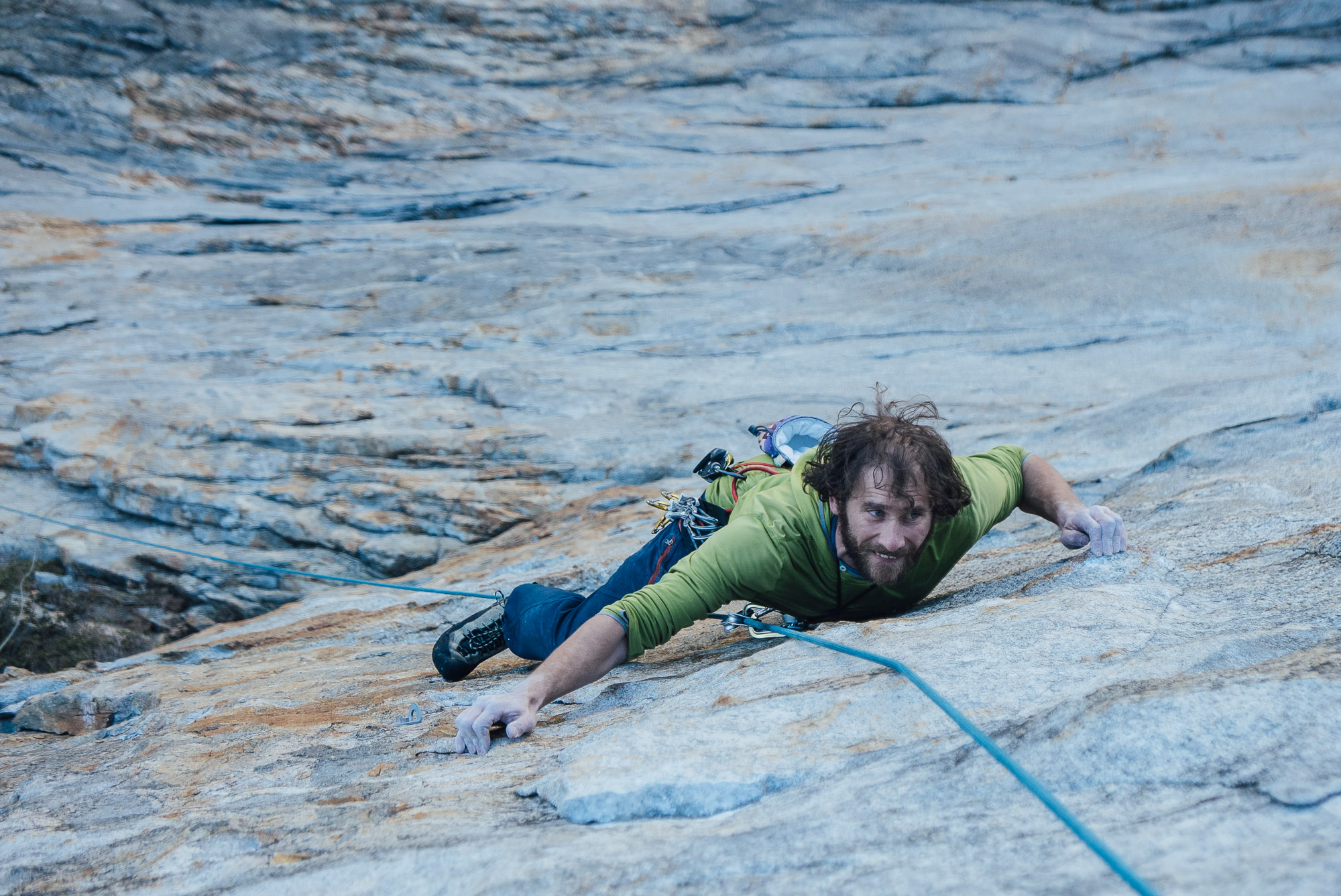
Max on Border Country.
At this point in the trip, after about a week, I knew El Cap was not going to happen. I wasn’t feeling much psych from Blake, which was reasonable because it was so warm. It was supposed to cool down after my wife, Liz, was going to arrive, and but I didn’t want to leave her to hang out alone for her first few days of her first trip to Yosemite. I talked to Josh Wharton and Nik Berry a bit about coming back later in November to have a shot at it, but they both either found partner before I committed or had an old partner come through later. Freeing El Cap was a big goal for 2017, something I really wanted to do, but it wasn’t meant to be. Good thing it’s not going anywere.
Monday, October 30th, was the last day I had to give another hard route a shot before I had to pick Liz up at the Sacramento airport that evening. Max had been working on the Westie Face (V 5.13a A0) of the Leaning Tower the previous season and was psyched to get back on it. I was pretty sure I had a good chance at sending it in a day, and maybe even a slight chance at an onsight. It was at least not out of the realm of possibility. Max’s goal was to re-remember the moves, so we decided I would lead most of the route.
The day before getting on the route, Max and I hiked up to the base to fix the initial 200ft bolt ladder that gets you into the free climbing. We rock-paper-scissored over who would lead it and I lost, which was probably a good thing because I had literally no aid climbing experience and a 200ft bolt ladder would probably be a good start. It felt like it took forever, even after getting into a rhythm of it. Without a hook, I had to pull a mandatory free move over a roof, that actually felt kinda hard in approach shoes. I made it through though and we were ready for a speedy ascent the next day.
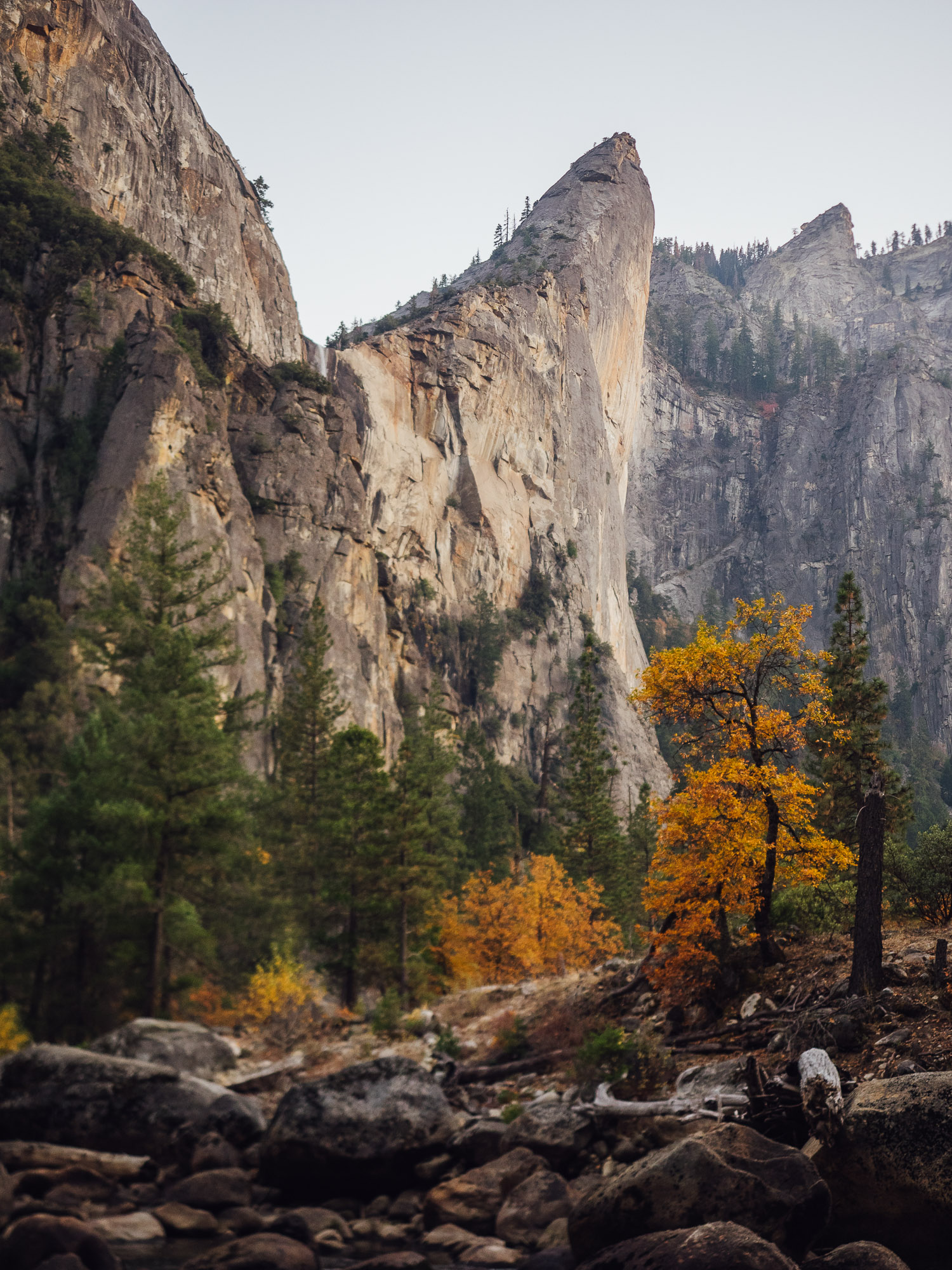
The Leaning Tower.
With a 5:30am alarm, we were probably at the base of our fixed line by 7:30am. We ascended our line to a hanging corner, several hundred feet off the ground. It was an intimidating start, needless-to-say, with 12c difficulties right off the belay. I didn’t handle the exposure and pressure to send very well and felt pretty shaky. I made it through the first cruxy moves but punted when I shook myself off a small foot. Blew the onsight. I lowered to the belay and yo-yo back up to where I fell before and finished the pitch. The next pitch, the crux pitch, contains two cruxy sections separated by a stance on a slab, a first one at around 12d, and a second at around 13a. As I was about to exiting the first crux, I tightened up, stopped breathing, and fell. I lowered, pulled the rope, and immediately got back on the pitch, still quite pumped. I relaxed my way through the first crux and onsighted the rest of the pitch, including the 13a crux. Having climbed the first two pitches almost twice each, I was already a bit tired and pumped with 4 more pitches of 5.12 and one 11+ to go. But the crux was behind me so I was pretty confident it would go. Sure enough, the rest of the pitches went first try. We topped out around 2pm and I was pretty pooped from all the steep climbing. I think I had been carrying a low-level flash pump with me the whole day. I was glad to send, but a little bummed about my poor performance on the first two pitches. We were back in El Portal by 5pm and I was at the Sacramento airport by 9pm to pick up Liz and back in El Portal after midnight. A long day, but good last day of hard climbing!
For the rest of the week, I was able to enjoy some of Yosemite’s classic moderate routes with Liz, like the East Buttress of Middle Cathedral, Nutcracker, and Serenity Crack. It was early November and the Valley was starting to clear out and quiet down. It was a fitting way to end the trip, but seeing El Cap everyday, and knowing that it would have to wait, made me a bit sad. But for now, I had had a great first “mature” trip to the Yosemite and a most excellent tour of the darker side of the valley.
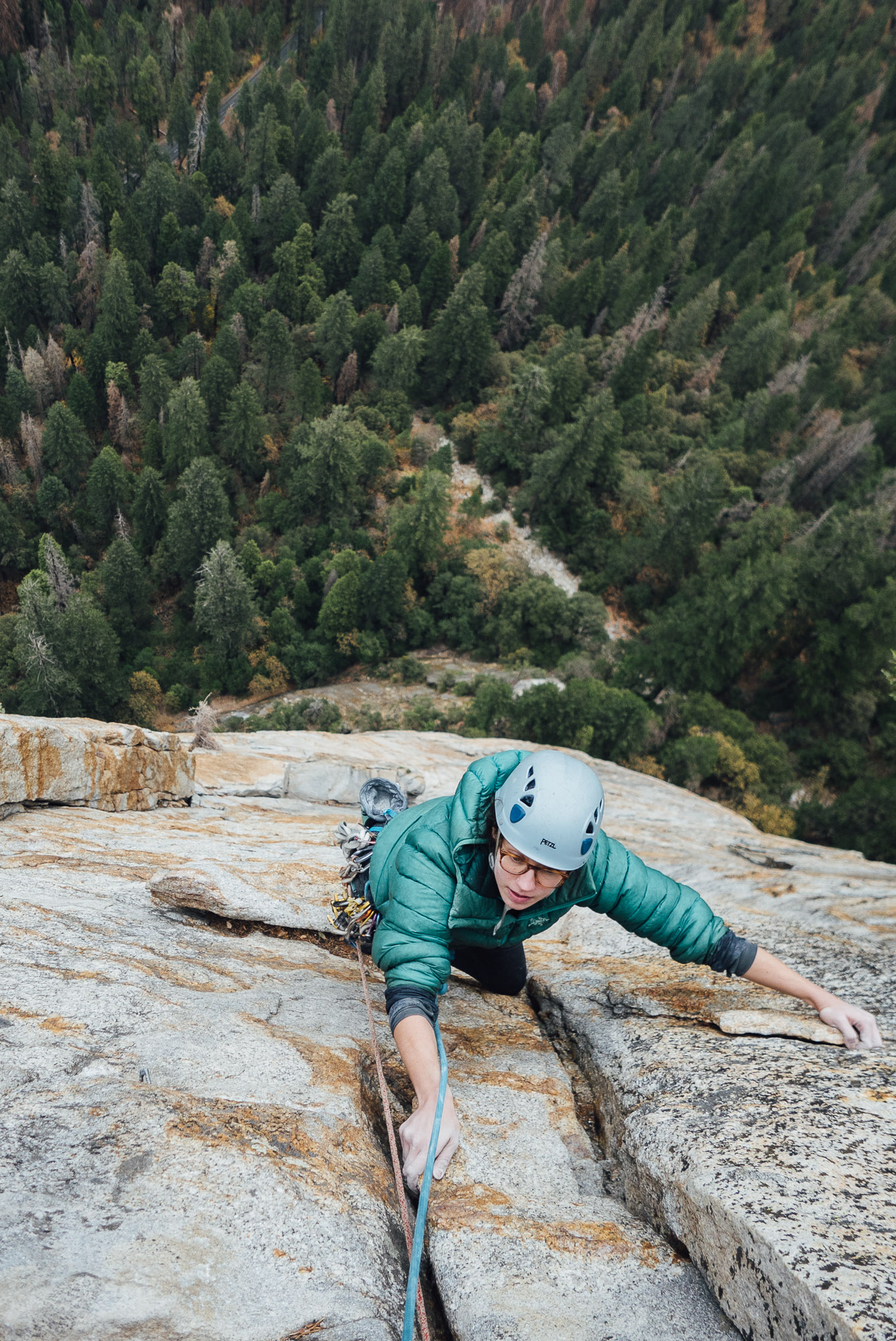
Liz on the East Buttress, Middle Cathedral.
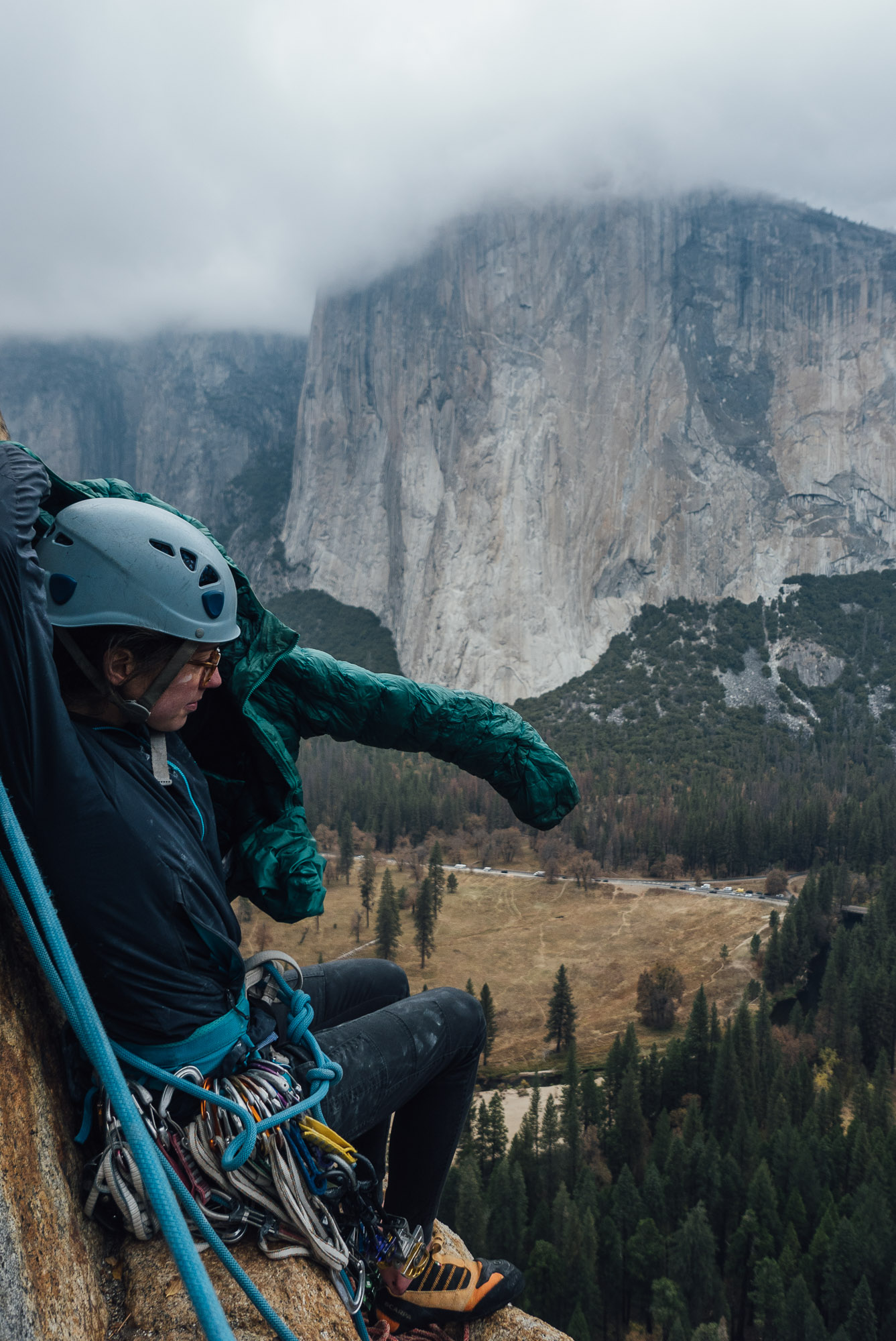
Moody day on Middle Cathedral.
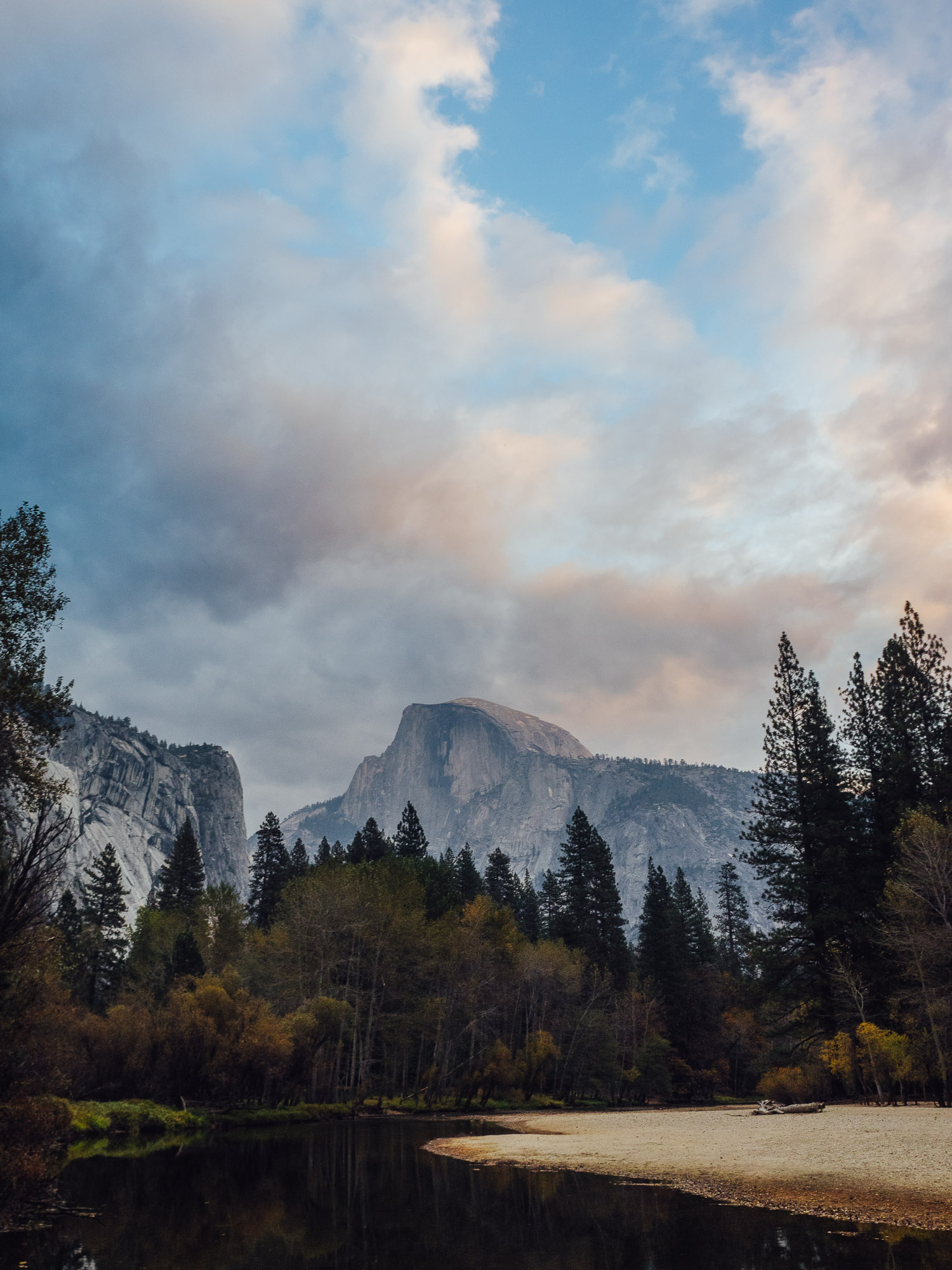
Half Dome.
Vanishing Point
My good friend, Travis Kemp, and I climbed Vanishing Point about a month ago, and I know some people have been curious about this route and would benefit from even a short trip report. There is still time to climb this route this season, but it's dwindling!
Vanishing Point on Dolomite Tower, a subpeak of Mt. Baring, climbs one of the most impressive, clean faces in the state, even country. The Liberty Bell group at Washington Pass is hard to beat as far as aesthetics and quality of climbing goes, but the north face of Mt. Baring is almost right up there with it. It's beautiful! But no one climbs on it!! Yeah, yeah, the rock is not quite as good. But the rock on Vanishing Point was overwhelmingly good--loose rock was the exception. If this thing was in Europe, it would probably be famous. I mean they climb on shit over there and this is definitely pretty good! Right? Just kidding...
Bryan Burdo first climbed his masterpiece Vanishing Point in 1999 and gave called it Grade VI 5.12b--which is a pretty big grade (The Nose on El Cap is Grade VI!). Taken as a whole, to climb the north face of Mt. Baring, you must ascend around 3000ft of semi-technical to very technical (overhanging!) terrain. To get the base of the Dolomite Tower prow ('the approach'), you must climb up steep gullies, a 60-70° forested rib with fixed lines, and around 800ft of mostly roped-up slab. Finally, where the real climbing starts, you have a nearly 1500ft overhanging prow looming above you that is VERY sustained at 5.11+/5.12. Bryan Burdo took 3-days on his ascent, though now, competent parties have done it in one long day.
Travis and I had been talking about doing this route since we saw it in Blake Herrington's book Cascade Rock. After a year of waffling, we finally set a date. In order to cut out the 1.5 hour drive from Seattle, we drove to Travis' cabin in Skykomish on a Thursday night after routesetting at Seattle Bouldering Project. The next day, we were up at 5am and were at the Barclay Lake Trailhead by around 6am. The approach starts out on a pleasant level trail until you reach a creek bed, which you can walk in, or alternatively, walk through relatively open forest right of the creek, until you reach a boulder field. Once in the boulder field, you can see your whole route: up a rocky wash to a ramp onto the forested rib; up fixed lines in the forested rib; back left into the gully; up the gully until reaching bolted slabs to the left; up the slabs; across a large ledge to the left; up a gully with bolts and gear occasionally on the face to the right; up more slabs and ledges diagonaling left to the base of the tower. (Phew! That's you're brief approach beta from me!). We nailed the 'approach' without pre-scouting, thanks to a good description in Blake's guidebook, and were at the base of Dolomite Tower at 8:30am.
Man, I'm writing more than I thought. I need to wrap this up! But onto the real climbing...but briefly! I lead the first two pitches combined with no event. Travis took the 3rd, which is runout and the site of a huge fall and injury of a competent northwest climber. Sure enough it was sketchy and scary--glad Travis lead it! We thought a #2, which we didn't have, might have protected the moves off of the flake. Pitch 4, the only all-gear pitch, was fun and well-protected. Then pitch 5, the pitch that almost ruined our day. Travis set off up towards a roof that we were supposed to climb through, according to Blake's description, but Travis found hard climbing, no bolts, and very loose rock that would likely break and fall directly on me. Spooked, he lowered and we talked about bailing. I decided I would go and check it out. I put in a #1 in a suspect flake under the roof and thought about committing to some slopers but had no idea what was above them. I bailed, and moved to the far right where there were some bolts on the face, back cleaning as I went to lessen the rope drag. I'm not sure of the difficulty of the climbing because of the hanging and back cleaning, but I was able to climb around the roof and the loose flakes to the 'alt. belay' marked in Blake's topo. OK, I thought, we were going to do this, but now it became about getting to the top. Free climbing wasn't the goal anymore. Just climbing fast. And that we did.
After many, many gloriously exposed, hard, sustained, overhanging, and nerve-numbing, but safe, pitches we reached the top 7.5 hours after starting at the base of the tower at around 4pm. The descent, thank god, though long, is fully non-technical, and we were back to the car at 6:30pm. Grade VI, car-to-car in 12.5 hours--not bad! Maybe Grade V is more appropriate... But since we failed to free climb the route, at least we were fast. And we were definitely happy--it was one of the most exciting climbs we had ever done. I definitely would do it again, but I might need some time to let the memory settle...
I talked to Blake afterward about pitch 5, and he dug up a picture of the roof from when he climbed it. Sure enough, as we suspected, a serious chunk of the roof is now gone. The route as they climbed it is no longer possible/recommended/safe. If it weren't for the mystery bolts out left, the route would not safely go. I have no idea how hard the climbing there is though, but probably between 5.11+ and 5.12+, so it is likely another crux. Below is a marked-up copy of Blake's topo. Do it!!
Archive
2023
Dreefee and Crystal Dawn
Rubbernecker
2022
Long's Peak Diamond
Seattle Design Festival Interview
Seeing Circuits: an Interview with the Bouldering Project
2020
Vanishing Point 2.0: A Classic Route Modernized
Interview with Steven Dimmitt
Training Using Circuits
Cuba
2019
Dark Side of Liberty
The Bugaboos
Blue Jeans Direct: The End of the Canadian Rockies Ticklist
The Path
The Shining Uncut
Castles in the Sky
Scarface
Index's First 5.14
Turkey
2018
Patagonia
2017
Dark Side of the Valley
Vanishing Point
Winter Climbing
First Route in the Alaska Range
New York Gully